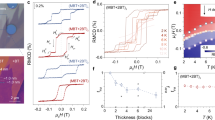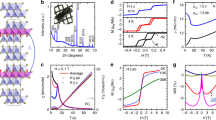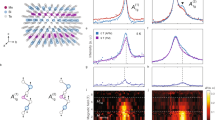Abstract
The intrinsic magnetic topological insulator MnBi2Te4 (MBT) provides a platform for the creation of exotic quantum phenomena. Novel properties can be created by modification of the MnBi2Te4 framework, but the design of stable magnetic structures remains challenging. Here we report ferromagnet-intercalated MnBi2Te4 superlattices with tunable magnetic exchange interactions. Using molecular beam epitaxy, we intercalate ferromagnetic MnTe layers into MnBi2Te4 to create [(MBT)(MnTe)m]N superlattices and examine their magnetic interaction properties using polarized neutron reflectometry and magnetoresistance measurements. Incorporation of the ferromagnetic spacer tunes the antiferromagnetic interlayer coupling of the MnBi2Te4 layers through the exchange-spring effect at MnBi2Te4/MnTe hetero-interfaces. The MnTe thickness can be used to modulate the relative strengths of the ferromagnetic and antiferromagnetic order, and the superlattice periodicity can tailor the spin configurations of the synthesized multilayers.
This is a preview of subscription content, access via your institution
Access options
Access Nature and 54 other Nature Portfolio journals
Get Nature+, our best-value online-access subscription
$29.99 / 30 days
cancel any time
Subscribe to this journal
Receive 12 digital issues and online access to articles
$119.00 per year
only $9.92 per issue
Buy this article
- Purchase on Springer Link
- Instant access to full article PDF
Prices may be subject to local taxes which are calculated during checkout





Similar content being viewed by others
Data availability
The data that support the plots within this paper and other findings of the study are available from the corresponding authors upon reasonable request.
References
Chang, C. Z. et al. Experimental observation of the quantum anomalous Hall effect in a magnetic topological insulator. Science 340, 167–170 (2013).
Kou, X. et al. Scale-invariant quantum anomalous Hall effect in magnetic topological insulators beyond the two-dimensional limit. Phys. Rev. Lett. 113, 137201 (2014).
Nomura, K. & Nagaosa, N. Surface-quantized anomalous Hall current and the magnetoelectric effect in magnetically disordered topological insulators. Phys. Rev. Lett. 106, 166802 (2011).
Li, R., Wang, J., Qi, X.-L. & Zhang, S.-C. Dynamical axion field in topological magnetic insulators. Nat. Phys. 6, 284–288 (2010).
He, K., Wang, Y. & Xue, Q.-K. Quantum anomalous Hall effect. Natl Sci. Rev. 1, 38–48 (2013).
Tokura, Y., Yasuda, K. & Tsukazaki, A. Magnetic topological insulators. Nat. Rev. Phys. 1, 126–143 (2019).
Kou, X. et al. Metal-to-insulator switching in quantum anomalous Hall states. Nat. Commun. 6, 8474 (2015).
Winnerlein, M. et al. Epitaxy and structural properties of (V, Bi, Sb)2Te3 layers exhibiting the quantum anomalous Hall effect. Phys. Rev. Mater. 1, 011201 (2017).
Lee, I. et al. Imaging Dirac-mass disorder from magnetic dopant atoms in the ferromagnetic topological insulator Crx(Bi0.1Sb0.9)2 − xTe3. Proc. Natl Acad. Sci. USA 112, 1316–1321 (2015).
He, Q. L. et al. Tailoring exchange couplings in magnetic topological-insulator/antiferromagnet heterostructures. Nat. Mater. 16, 94–100 (2017).
Katmis, F. et al. A high-temperature ferromagnetic topological insulating phase by proximity coupling. Nature 533, 513–516 (2016).
Lang, M. et al. Proximity induced high-temperature magnetic order in topological insulator-ferrimagnetic insulator heterostructure. Nano Lett. 14, 3459–3465 (2014).
Tang, C. et al. Above 400-K robust perpendicular ferromagnetic phase in a topological insulator. Sci. Adv. 3, e1700307 (2017).
Deng, Y. et al. Quantum anomalous Hall effect in intrinsic magnetic topological insulator MnBi2Te4. Science 367, 895–900 (2020).
Li, J. et al. Intrinsic magnetic topological insulators in van der Waals layered MnBi2Te4-family materials. Sci. Adv. 5, eaaw5685 (2019).
Otrokov, M. M. et al. Prediction and observation of an antiferromagnetic topological insulator. Nature 576, 416–422 (2019).
Gong, Y. et al. Experimental realization of an intrinsic magnetic topological insulator. Chin. Phys. Lett. 36, 076801 (2019).
Otrokov, M. M. et al. Highly-ordered wide bandgap materials for quantized anomalous Hall and magnetoelectric effects. 2D Mater. 4, 025082 (2017).
Liu, C. et al. Robust axion insulator and Chern insulator phases in a two-dimensional antiferromagnetic topological insulator. Nat. Mater. 19, 522–527 (2020).
Yan, J.-Q. et al. A-type antiferromagnetic order in MnBi4Te7 and MnBi6Te10 single crystals. Phys. Rev. Mater. 4, 054202 (2020).
Wu, J. et al. Toward 2D magnets in the (MnBi2Te4)(Bi2Te3)n bulk crystal. Adv. Mater. 32, 2001815 (2020).
Klimovskikh, I. I. et al. Tunable 3D/2D magnetism in the (MnBi2Te4)(Bi2Te3)m topological insulators family. npj Quant. Mater. 5, 54 (2020).
Ding, L. et al. Crystal and magnetic structures of magnetic topological insulators MnBi2Te4 and MnBi4Te7. Phys. Rev. B 101, 020412 (2020).
Vidal, R. C. et al. Topological electronic structure and intrinsic magnetization in MnBi4Te7: a Bi2Te3 derivative with a periodic Mn sublattice. Phys. Rev. X 9, 041065 (2019).
Shi, M. Z. et al. Magnetic and transport properties in the magnetic topological insulators MnBi2Te4(Bi2Te3)n (n = 1, 2). Phys. Rev. B 100, 155144 (2019).
He, K. & Xue, Q.-K. The road to high-temperature quantum anomalous Hall effect in magnetic topological insulators. SPIN 09, 1940016 (2019).
Cao, L. et al. Growth and characterization of the dynamical axion insulator candidate Mn2Bi2Te5 with intrinsic antiferromagnetism. Phys. Rev. B 104, 054421 (2021).
Li, H. et al. Antiferromagnetic topological insulator MnBi2Te4: synthesis and magnetic properties. Phys. Chem. Chem. Phys. 22, 556–563 (2020).
Zhao, Y.-F. et al. Even-odd layer-dependent anomalous Hall effect in topological magnet MnBi2Te4 thin films. Nano Lett. 21, 7691–7698 (2021).
Chen, P. et al. Tailoring the hybrid anomalous Hall response in engineered magnetic topological insulator heterostructures. Nano Lett. 20, 1731–1737 (2020).
Scholl, A., Liberati, M., Arenholz, E., Ohldag, H. & Stöhr, J. Creation of an antiferromagnetic exchange spring. Phys. Rev. Lett. 92, 247201 (2004).
Park, B. G. et al. A spin-valve-like magnetoresistance of an antiferromagnet-based tunnel junction. Nat. Mater. 10, 347–351 (2011).
He, K. MnBi2Te4-family intrinsic magnetic topological materials. npj Quant. Mater. 5, 90 (2020).
Awana, G. et al. Critical analysis of proximity-induced magnetism in MnTe/Bi2Te3 heterostructures. Phys. Rev. Mater. 6, 053402 (2022).
Boltaev, A., Pudonin, F., Sherstnev, I., Egorov, D. & Kozmin, A. Flat magnetic exchange springs as mechanism for additional magnetoresistance in magnetic nanoisland arrays. J. Magn. Magn. Mater. 428, 132–135 (2017).
Nogués, J. & Schuller, I. K. Exchange bias. J. Magn. Magn. Mater. 192, 203–232 (1999).
Hellwig, O., Kortright, J., Takano, K. & Fullerton, E. E. Switching behavior of Fe-Pt/Ni-Fe exchange-spring films studied by resonant soft-X-ray magneto-optical Kerr effect. Phys. Rev. B 62, 11694–11698 (2000).
Khan, M. Y., Shokr, Y. A. & Kuch, W. Coupling of pinned magnetic moments in an antiferromagnet to a ferromagnet and its role for exchange bias. J. Phys. Condens. Matter 32, 075801 (2019).
Chi, X. et al. Role of antiferromagnetic bulk exchange coupling on exchange-bias propagation. Phys. Lett. A 379, 2772–2776 (2015).
Guo, S. et al. Influence of antiferromagnetic interlayer on the exchange coupling of FM1/AFM/FM2 multilayers. J. Magn. Magn. Mater. 344, 35–38 (2013).
Bali, R. et al. Competing magnetic anisotropies in an antiferromagnet-ferromagnet-antiferromagnet trilayer. J. Appl. Phys. 106, 113925 (2009).
Rößler, U. & Bogdanov, A. Magnetic phases and reorientation transitions in antiferromagnetically coupled multilayers. Phys. Rev. B 69, 184420 (2004).
Wang, Z. et al. Determining the phase diagram of atomically thin layered antiferromagnet CrCl3. Nat. Nanotechnol. 14, 1116–1122 (2019).
Yang, S. et al. Odd-even layer-number effect and layer-dependent magnetic phase diagrams in MnBi2Te4. Phys. Rev. X 11, 011003 (2021).
Kneller, E. F. & Hawig, R. The exchange-spring magnet: a new material principle for permanent magnets. IEEE Trans. Magn. 27, 3588–3560 (1991).
Fullerton, E. E., Jiang, J. & Bader, S. Hard/soft magnetic heterostructures: model exchange-spring magnets. J. Magn. Magn. Mater. 200, 392–404 (1999).
Gruyters, M. & Schmitz, D. Microscopic nature of ferro- and antiferromagnetic interface coupling of uncompensated magnetic moments in exchange bias systems. Phys. Rev. Lett. 100, 077205 (2008).
Lu, J. et al. Design and synthesis of an artificial perpendicular hard ferrimagnet with high thermal and magnetic field stabilities. Sci. Rep. 7, 16990 (2017).
Meng, L. et al. Anomalous thickness dependence of Curie temperature in air-stable two-dimensional ferromagnetic 1T-CrTe2 grown by chemical vapor deposition. Nat. Commun. 12, 809 (2021).
He, Y. et al. Large linear non-saturating magnetoresistance and high mobility in ferromagnetic MnBi. Nat. Commun. 12, 4576 (2021).
Butler, W., Zhang, X.-G., Nicholson, D. & MacLaren, J. Spin-dependent scattering and giant magnetoresistance. J. Magn. Magn. Mater. 151, 354–362 (1995).
Maranville, B., Ratcliff, W. & Kienzle, P. reductus: a stateless Python data reduction service with a browser front end. J. Appl. Crystallogr. 51, 1500–1506 (2018).
Kirby, B. J. et al. Phase-sensitive specular neutron reflectometry for imaging the nanometer scale composition depth profile of thin-film materials. Curr. Opin. Colloid Interface Sci. 17, 44–53 (2012).
Blöchl, P. E. Projector augmented-wave method. Phys. Rev. B 50, 17953–17979 (1994).
Kresse, G. & Furthmüller, J. Efficient iterative schemes for ab initio total-energy calculations using a plane-wave basis set. Phys. Rev. B 54, 11169–11186 (1996).
Kresse, G. & Joubert, D. From ultrasoft pseudopotentials to the projector augmented-wave method. Phys. Rev. B 59, 1758–1775 (1999).
Perdew, J. P., Burke, K. & Ernzerhof, M. Generalized gradient approximation made simple. Phys. Rev. Lett. 77, 3865–3868 (1996).
Anisimov, V. I., Zaanen, J. & Andersen, O. K. Band theory and Mott insulators: Hubbard U instead of Stoner I. Phys. Rev. B 44, 943–954 (1991).
Dudarev, S. L., Botton, G. A., Savrasov, S. Y., Humphreys, C. & Sutton, A. P. Electron-energy-loss spectra and the structural stability of nickel oxide: an LSDA+U study. Phys. Rev. B 57, 1505–1509 (1998).
Klimeš, J., Bowler, D. R. & Michaelides, A. Van der Waals density functionals applied to solids. Phys. Rev. B 83, 195131 (2011).
Lado, J. L. & Fernández-Rossier, J. On the origin of magnetic anisotropy in two dimensional CrI3. 2D Mater. 4, 035002 (2017).
Acknowledgements
This work is sponsored by the National Key R&D Program of China under contract no. 2017YFA0305400, the National Natural Science Foundation of China (grants nos. 61874172 and 11904230), the Major Project of Shanghai Municipal Science and Technology (grant no. 2018SHZDZX02), the Shanghai Engineering Research Center of Energy Efficient and Custom AI IC, and the Shanghaitech Quantum Device and Soft Matter Nano-fabrication Labs (SMN180827). X.K. acknowledges support from the Merck POC programme and the Shanghai Rising-Star programme (grant no. 21QA1406000). Y.Y. acknowledges support from Shanghai Pujiang Program (grant no. 20PJ1411500). We acknowledge the facilities, and scientific and technical assistance, of the Australian Microscopy & Microanalysis Research Facility at the Centre for Microscopy and Microanalysis, The University of Queensland. Q.Y. acknowledges support from the Shanghai Sailing Program (grant no. 19YF1433200). We would also like to thank the ISIS neutron facility for the award of beam time (RB2000244, https://doi.org/10.5286/ISIS.E.RB2000244). Certain commercial equipment is identified in this paper to foster understanding. Such identification does not imply recommendation or endorsement by NIST. Diamond Light Source is acknowledged for the beam time allocated on I10 under proposal MM30262. B.A. and T.H. acknowledge funding from the Engineering and Physical Sciences Research Council (EP/N032128/1). F.X. was supported by the National Natural Science Foundation of China (52225207 and 52150103), the Shanghai Municipal Science and Technology Major Project (grant no. 2019SHZDZX01), the Program of Shanghai Academic/Technology Research Leader (grant no. 20XD1400200) and the Shanghai Pilot Program for Basic Research—FuDan University 21TQ1400100 (21TQ006).
Author information
Authors and Affiliations
Contributions
X.K. and Q.Y. conceived and supervised the study. P.C. and S. Liu grew the samples. P.C., J.L. and P.H. performed the characterization measurements and conducted the transport measurements. Q.Y. and P.C. analysed the transport and characterization data. P.C. and Y.Y. conducted the macro-spin simulations. J.X. and H.Z. contributed the first-principles calculations. Q.S., A.L., X.H. and J.Z. performed the transmission electron microscopy characterization. A.J.G., P.Q., P.P.B., C.J.K., A.J.C. and S. Langridge performed the neutron reflectometry measurements. B.A., E.H. and T.H. performed X-ray magnetic circular dichroism measurements, and S. Liu, B.C., G.Y. and F.X. performed superconducting quantum interference device measurements. Y.J. and Z.L. performed the angle-resolved photoemission spectroscopy measurements. P.C., Q.Y., Y.Y. and X.K. wrote the manuscript. All authors discussed the results and commented on the manuscript.
Corresponding authors
Ethics declarations
Competing interests
The authors declare no competing interests.
Peer review
Peer review information
Nature Electronics thanks Xianhui Chen and the other, anonymous, reviewer(s) for their contribution to the peer review of this work.
Additional information
Publisher’s note Springer Nature remains neutral with regard to jurisdictional claims in published maps and institutional affiliations.
Supplementary information
Supplementary information
Supplementary sections 1–12 and Figs. 1–12.
Rights and permissions
Springer Nature or its licensor (e.g. a society or other partner) holds exclusive rights to this article under a publishing agreement with the author(s) or other rightsholder(s); author self-archiving of the accepted manuscript version of this article is solely governed by the terms of such publishing agreement and applicable law.
About this article
Cite this article
Chen, P., Yao, Q., Xu, J. et al. Tailoring the magnetic exchange interaction in MnBi2Te4 superlattices via the intercalation of ferromagnetic layers. Nat Electron 6, 18–27 (2023). https://doi.org/10.1038/s41928-022-00880-1
Received:
Accepted:
Published:
Issue Date:
DOI: https://doi.org/10.1038/s41928-022-00880-1



